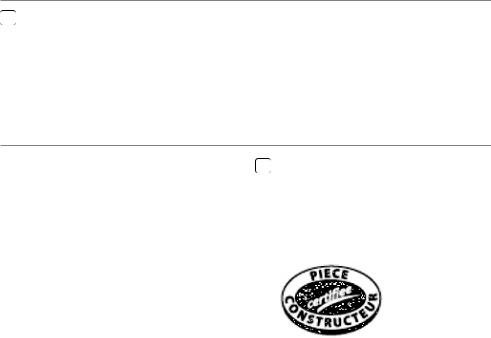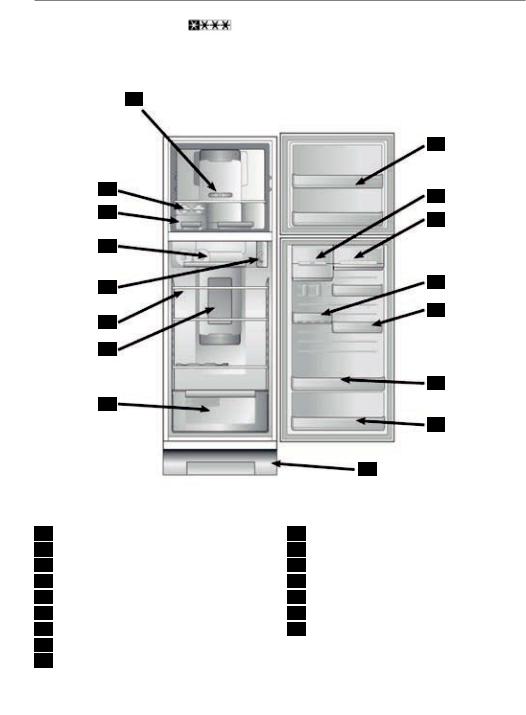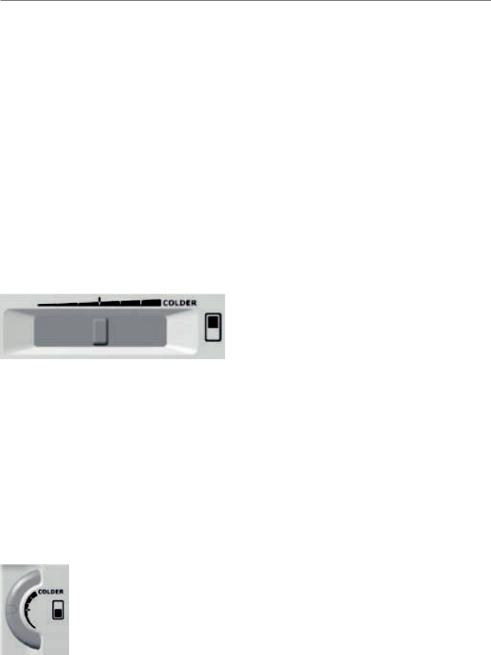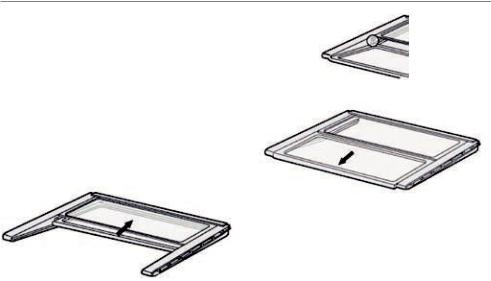ELECTROLUX END32320W User Manual [es]

EN ES
user manual manual de instrucciones
Refrigerator
Frigorífico
END32320W/X

2 electrolux
During its manufacture, this appliance was built in compliance with the standards, directives and/or decrees for use on French territory.
To ensure the safety of property and persons, as well as to respect the Environment, you should first read the instructions provided herein before using your new appliance.
To avoid the risk of damaging the appliance in any way, carry it to its installation point with the transport wedges (depending on the model) still on.
When unpacking the appliance, and to avoid risks of suffocation or personal injury, keep all packaging materials out of children’s reach.
To avoid all risks (damage to furniture or property, personal injury, ...), the installation, connections (water, gas, electricity, drainage, depending on the
model), commissioning and maintenance of your appliance must be performed by a qualified professional.
Your appliance has been designed to be used by adults. It is intended for normal domestic use. Do not use it for commercial or industrial purposes or for purposes other than those for which it
was designed. You will thus avoid the risk of any personal and material damage.
Unplug the appliance before performing any manual cleaning tasks. Only
use non corrosive or non-flammable products readily available on the market. Any spraying of water or steam is strictly forbidden to avoid the risk of electrocution.
If your appliance is fitted with a light, unplug it before replacing the light bulb (or neon light, etc.) to avoid the risk of electrocution.
In order to prevent an explosion or a fire, do not place flammable products or items soaked in flammable products inside, close to or on the appliance.
When scrapping your appliance, to avoid any risk of personal injury, decommission anything which could be dangerous: cut off the power supply cable flush with the appliance. Find out from your local council where the nearest authorised scrapping facility is.
Make sure the recommended low temperature is maintained from the time you purchase a food item until you eat it to avoid all risk of food poisoning.
Please read the instructions herein for the best use of your new appliance.
This appliance must be installed by a qualified professional and in compliance with the applicable regulations in force.

electrolux 3
Electrolux. Thinking of you.
Share more of our thinking at www.electrolux.com
Contents
Information for the user |
|
Important warnings and advice |
3 |
Service/Repair work |
4 |
Storing food in the refrigerator |
|
and hygiene rules |
5 |
Protecting the environment |
6 |
After-sales service |
6 |
Appliance description |
7 |
Use |
8 |
On commissioning |
8 |
Thermostats |
8 |
Refrigerator compartment |
8 |
Temperature indicator |
8 |
Food storage position |
9 |
Modular units |
9 |
Maintenance |
11 |
Maintenance and cleaning |
11 |
Defrosting |
11 |
Cleaning |
11 |
Replacing the light bulb |
12 |
In the event of prolonged absence |
|
or non-use |
13 |
In the event of a shutdown |
13 |
In the event of a malfunction |
13 |
Information for the fitter |
|
Technical characteristics |
14 |
Installation |
15 |
Positioning |
15 |
On commissioning |
15 |
Electrical connection |
15 |
Subject to change
How to read this user manual
The symbols below will guide you as you read through this user’s guide:
 Safety instructions
Safety instructions
Important warnings and advice
 Tips and advice
Tips and advice
 Information on caring for the Environment
Information on caring for the Environment
It is vital to keep this user’s guide together with the appliance for future reference. Should this appliance be sold or transferred to another owner, make sure it is accompanied by the user’s guide, so that the new user can find out about how it operates and the related warnings.
This appliance is fitted with magnetic doors. If it is a replacement for an appliance fitted with spring doors, we recommend you decommission the latter before scrapping it. This is to avoid children accidentally getting trapped inside and put their lives in danger. These warnings are given for your safety and that of others. Therefore please read them carefully before installing and using the appliance.
Safety
•This appliance is not intended for use by children or by persons whose physical, sensory or mental abilities, or whose lack of experience and knowledge prevent them from using the appliance safely when unsupervised or in the absence of instructions from a responsible person who can ensure the appliance is used safely.
•Always unplug the appliance from the socket before cleaning the interior and exterior of the appliance and when replacing the light bulb for the internal light (for appliances fitted with one).
•Do not touch icy surfaces and frozen goods with wet or damp hands and do not eat certain foods such as ice lollies as soon as you remove them from the appliance; the very low temperature at which they

4 electrolux
were stored could cause frostbite or tearing of the skin.
•This appliance is heavy. Take care when moving it.
•Be extremely careful when moving the appliance so as not to damage parts of the refrigeration circuit and thereby to avoid the risk of leakage.
•The appliance must not be placed near radiators or gas cookers.
•Avoid exposing the appliance to the sun’s rays for extended periods of time.
•There must be sufficient air circulation at the rear of the appliance and you must avoid damaging the refrigeration circuit in any way.
•Do not operate electrical devices inside the appliance.
Service/Repair work
•Entrust the electrical work in your home required for the installation of your new appliance only to a qualified electrician.
•Do not modify or attempt to modify the characteristics of this appliance.
•In compliance with UTE – C – 73 – 997 regulation of July 2006, only people who have had specific training in handling flammable liquids may work on this appliance, which contains hydrocarbons. This is nonetheless a flammable gas: During the transportation and installation of your appliance, make sure that the circuit is not damaged in any way. If it should be:
−−Avoid naked flames (lighter) and any other ignition (sparks).
−−Air the room in which the appliance is situated.
•In the event of a breakdown, do not attempt to repair the appliance yourselves. Repairs carried out by unqualified staff could damage the appliance irreparably. Contact the After-Sales Service of your retailer and demand original spare parts only.
Use
•Your appliance is intended for normal domestic use. Do not use it for commercial or industrial purposes or for purposes other than those for which it was designed.
•Domestic refrigerators and/or freezers are intended solely for the preservation and/or freezing of food.
•For the appliance to operate correctly, it is vital that you observe the ambient temperatures of the room in which the appliance is located, according to the
climate class (indicated on the data plate)
for which it was designed. Beyond these temperatures, the appliance performance levels may drop.
The different existing climate classes and the corresponding ambient temperatures depending on the appliance model are as follows: between +18°C and +43°C (class T), between + 18°C and + 38°C (class ST), between + 16°C and + 32°C (class N), between + 10°C and + 32°C (class SN).
•Never refreeze a defrosted product.
•Follow the manufacturer’s instructions on food preservation and/or freezing.
•All refrigeration and freezing appliances feature surfaces which get covered in ice. Depending on the model, this ice can be removed automatically (automatic defrosting) or manually.
•Never attempt to remove the ice with a metallic object, as this could irreparably damage the evaporator and at the same time make the appliance unusable.
Only use a plastic spatula to remove ice manually.
•Similarly, never detach the ice trays with a knife or other sharp object.
•Do not place any bottles or cans of sparkling drinks in the freezer/low temperature compartment, as they could burst.

electrolux 5
Storing food in the refrigerator and hygiene rules
The widespread use of ready meals and other fragile foods, especially sensitive to any failure to keep them at the recommended low temperature1, has made it necessary to improve the control of the transportation and storage temperatures of such products.
At home, the correct use of the refrigerator and the observance of strict hygiene rules play a significant and effective role in improving food preservation.
Food preservation / Temperature control
Store foods in the appropriate zone of the appliance, depending on their nature:
Temperate zone: Beverages, eggs, butter, industrial and home-made sauces, cooked cheese, fresh fruit and vegetable.
Fresh zone: Dairy products, dairy desserts, fat products, fresh cheese.
Coldest chill zone: meat, poultry, fish, cold cuts, ready meals, mixed salads, creamor egg-based dishes and cakes, fresh pasta, pastry, pizzas / quiches, fresh products
and unpasteurized cheese, ready-to-cook vegetables in plastic sachets and more generally all fresh produce with a use by date associated with a storage temperature of +4°C or less.
Observing the following advice will avoid cross contamination and prevent the incorrect preservation of foods.
•Wrap all food systematically to avoid cross contamination.
•Always wash your hands before handling food and several times when preparing meals if this entails the subsequent handling of different products, and afterwards too, before eating, according to the best hygiene rules.
•Do not re-use dirty utensils (wooden spoons, chopping boards before washing them first).
•Wait for dishes to have cooled down completely before refrigerating or freezing them (such as soup).
•Limit the number of times you open the door and, under all circumstances, do not leave the door open for too long to avoid the temperature inside it rising.
•Arrange food so that air can circulate freely around it.
It is advisable to check regularly that the temperature, especially that in the coldest zone, is correct and if this is not the case, adjust the thermostat accordingly as indicated (page on “Use”).
The temperature in a particular zone (on a shelf, for example) can be measured using a thermometer placed from the onset in a glass full of water.
To have a truthful temperature reading, read the thermometer without adjusting any of the controls or opening the door.
Observing the hygiene rules
•Clean the interior of the refrigerator frequently using a mild oxidant-free detergent on the metal parts, then rinse with water mixed with lemon juice, white vinegar or specific refrigerator disinfectant.
•Remove any overwrapping before placing food inside the refrigerator (such as the outer packaging on yoghurt pots).
•Cover all food.
•Consult the appliance user’s guide under all circumstances and in particular for care tips.
1 Recommended low temperature: maintaining without disruption the temperature required by a product, from the time it is prepared and processed until it is eaten by the consumer.

6 electrolux
Installation
•Make sure, after the appliance has been installed, that it is not placed on top of the power supply cable.
Important: if the power supply cable is damaged, it should only be replaced by a qualified professional.
•The appliance gets rather hot near the condenser and compressor. Make sure air circulates freely all around the appliance.
Insufficient ventilation could entail an appliance malfunction or even damage. Follow the installation instructions provided.
•After delivery, wait 2 hours before pluggingin the appliance to allow the refrigeration circuit to stabilise.
Protecting the environment
 The refrigeration system and the insulation of your appliance are free of any C.F.C.s, and thus help contribute to the conservation of the Environment. The appliance cannot be treated like domestic waste. When the appliance is scrapped, avoid damaging the refrigeration circuit,
The refrigeration system and the insulation of your appliance are free of any C.F.C.s, and thus help contribute to the conservation of the Environment. The appliance cannot be treated like domestic waste. When the appliance is scrapped, avoid damaging the refrigeration circuit,
especially at the rear of the appliance, near the condenser. For further details on recycling this product, please contact your local council or the store where you purchased it. The materials used in this appliance marked with the symbol are recyclable.
After-sales service
In the event of a malfunction, please look under the heading of “Malfunctions”. If despite all your checks, work needs to be done, the retailer who sold you the appliance is the first person to contact. If this is not possible (if you have moved, if the store where you purchased the appliance has closed, ...), please contact the Consumer Care Centre who will provide the address of your nearest After-Sales Service point.
If work needs to be done on your appliance, insist on the after-sales centre using spare parts certified by the Manufacturer.
 Data plate
Data plate
When you call the After-Sales Service, specify the appliance model, product number and serial number. This information can be found on the appliance data plate.

electrolux 7
Appliance description
Your appliance is fitted with a compartment. It is therefore designed to preserve frozen and deep-frozen shop-
bought food, to freeze fresh food and to make ice cubes.
16
15
14
13
12
11
10
9
1Freezer compartment storage tray
2Half-door storage tray
3Half-door storage tray
4Half-door storage tray
5Half-door storage tray
6Bottle storage
7Door storage tray
8Plinth
9Vegetable drawer
1
2
3
4
5
6
7
8
10Light
11Shelf
12Refrigerator compartment thermostat
13Chiller compartment
14Ice cube tank
15Ice cube tray
16Freezer compartment thermostat

8 electrolux
Use
Before plugging-in and adjusting your appliance, leave it approximately 3 hours on stand-by, in a vertical position, or for 5 hours if it was transported on its side.
On commissioning
Your appliance is designed for storing food, so take care to clean the interior with warm water and odourless detergent (washing-up liquid) before use. Rinse and dry thoroughly.
If you unplug or turn off the appliance, wait at least 10 minutes before plugging it back in or turning it back on to avoid damaging the compressor.
Your appliance is ventilated, which is why it is normal, during operation, to hear the noise of circulating air generated by the appliance fan.
Thermostats
On commissioning or after an extended period of appliance downtime and if you wish to use the freezer compartment, set the freezer compartment thermostat to the “COLDER” setting for approximately 2 hours before putting any frozen or deep-frozen foods inside the freezer compartment.
Then set the thermostat back to a normal operating setting.
Notes:
The temperature inside the compartments depends on several factors, such as the ambient temperature, the quantity of food stored, the frequency with which the door is opened, etc.
Refrigerator compartment
Temperature indicator
Freezer compartment
The temperature inside each compartment is adjusted using a thermostat graduated from a minimum position up to a maximum “COLDER” position, where the “COLDER” position is the coldest temperature.
Since the “minimum position” and “COLDER” settings are extremes, we advise you to make the initial commissioning adjustment to a setting in between, taking into account the following comments: subsequently, your experience alone will allow you to decide which is the best setting.
Refrigerator compartment
To assist you in setting your appliance correctly, we have fitted your refrigerator with a temperature indicator, which is located in the coldest zone.
For the proper preservation of the food inside your refrigerator, and in particular in the coldest zone, make sure the temperature indicator displays “OK”.
If “OK” is not displayed, the average temperature of the zone is too high. Adjust the thermostat to a higher setting.
Since the word “OK” appears in black, it is difficult to see if the temperature indicator is not lit properly. It is easier to read if it is lit correctly.
Every time the thermostat setting is changed, wait for the temperature inside the appliance to stabilise before changing to another setting, if necessary. Only change the thermostat setting progressively and wait at least 12 hours before running another check and making another change if necessary.
N.B. : Once you have loaded all your fresh food into the refrigerator or after the door has been opened repeatedly (or left open for an extended period of time), it is normal that the word “OK” does not appear in the

temperature indicator; wait at least 12 hours before readjusting the thermostat setting.
Food storage position
The principle of “VENTILATED COOLING” aims at distributing an even temperature throughout the interior of the refrigerator. The ideal temperature which is thus guaranteed on all the refrigerator shelves makes for greater freedom in the storage of all foodstuffs and affords improved and prolonged food preservation.
 Our advice
Our advice
•Store only fresh, clean produce wrapped in packaging or packed in appropriate food grade boxes (a variety of different models are available for purchase).
•Observe the advice for food storage and the food hygiene rules provided in the paragraph entitled “Important warnings”.
electrolux 9
•To ensure the proper circulation of air, never cover the refrigerator shelves with paper or plastic.
Notes: bananas, potatoes, garlic and onions should not be stored in the refrigerator. Fermented cheeses should only be stored
in the refrigerator if you wish to stop them maturing any further. In this case, they should be wrapped carefully.
Door alarm
If the refrigerator compartment door remains open for more than two minutes approximately, an alarm sounds.
Shut the door correctly to silence the alarm.
Modular units
Refrigerator compartment
Shelves
The runners fitted on the sides of the appliance interior allow you to position the shelves at different heights.
Half-shelf
If your appliance is fitted with a half-shelf, you can move the half-shelf forward to place taller items on the shelf below.
To do so:
•Lower the rear of the front half-shelf.
•Push the front half-shelf all the way under the rear half-shelf.
• Pull the half-shelf slightly forward.

10 electrolux
Vegetable drawer
The vegetable drawer is designed for preserving fruit and vegetables.
The shelf on top of the vegetable drawer is fitted with a device featuring slots which can be adjusted by means of a lever. The purpose of this device is to delay the dehydration of fruit and vegetables, keeping them fresh and thus prolonging their preservation life.
If you have to remove this shelf (when cleaning, for instance), make sure you reposition it correctly.
Door storage trays
You can remove these storage trays to clean them.
Freezer compartment
Shelf
You can remove this shelf to clean it.
Frozen food storage box
Place frozen food inside this box.
Door storage trays
These storage trays are designed to store food.
How to freeze
Your appliance is marked with the industrystandard 4 stars , meaning you can store your own fresh foods and cooked dishes inside it.
Freezing food means lowering its core temperature to -18°C as quickly as possible.
To do so:
1.Set the freezer compartment thermostat to the “COLDER” setting.
−−3 hours before placing fresh food inside the appliance if it is empty (on commissioning, for instance).
−−24 hours* before placing fresh food inside the appliance if it contains frozen food, and if you are using the maximum freezing capacity.
2.Maintain the freezer setting for 24 hours* after placing the food for freezing inside it.
3.Now return the appliance to a preservation setting by adjusting the thermostat to a middle setting.
* These time frames can be reduced in proportion to the quantity of food to be frozen.
To freeze under the best conditions:
Observe the freezing capacity of your appliance, namely the maximum quantity of fresh food which can be frozen in 24 hours.
The freezing capacity of your appliance is specified in the section entitled “Technical characteristics”.
Avoid storing fresh produce directly in contact with frozen foods.
Preserving shop-bought frozen and deep-frozen foods
For the correct preservation of frozen and deepfrozen foods, the temperature inside the freezer compartment should be kept at -18°C or less.
Make sure the food packaging is intact and that there are no signs of moisture, which indicates defrosting has begun.
Plan the shortest transportation time between the food store and your home. Use insulated shopping bags (wherever possible).
Find the date of preparation of the item and keep to the manufacturer’s recommended preservation time.
Avoid opening the freezer compartment door too often and only leave it open for the requisite amount of time.
An increase in temperature could drastically reduce the preservation life of food.
